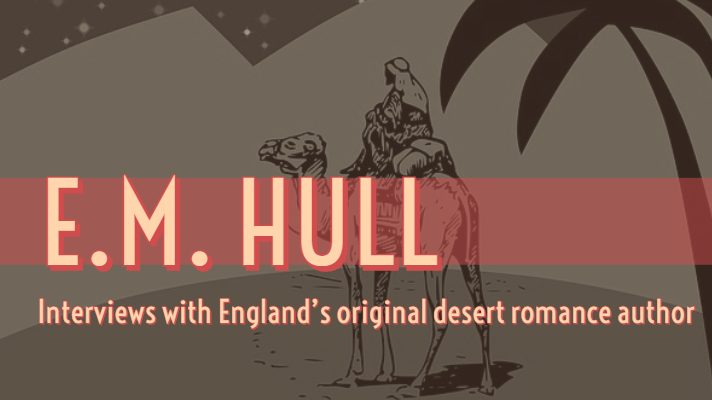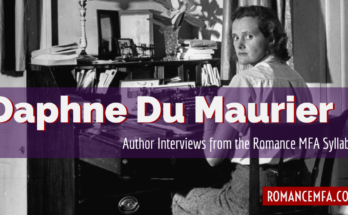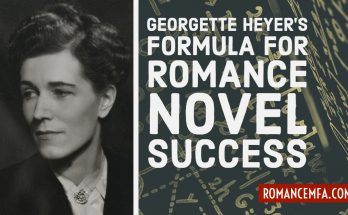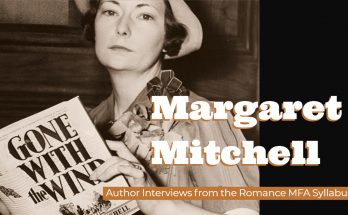Who was the woman behind The Sheik? Interviews with E.M. Hull are hard to come by. Billie Melman writes in the 1988 book Women And The Popular Imagination In The Twenties: Flappers And Nymphs,
The popular newspapers which feted A.S.M. Hutchinson and Margaret Kennedy and chronicled faithfully the social life of Michael Arlen completely ignored E.M. Hull. She was not interviewed, nor did her name appear in the society and gossip columns. To the literary critics her work was beneath contempt. … What is particularly remarkable in contemporary commentary on The Sheik is that, regardless of the critics’ platform and the readers they addressed, it is the best-selling book, not the best-selling writer, they focus on. … And this obliteration of the person of the writer (significantly, no photograph of E.M. Hull survives) at a period when best-selling writers made headlines is striking.
However, Jaelyn Glennmeier, in a 2018 honors thesis for the University of Kansas [pdf], discusses a 1922 interview with Hull in Nash’s and Pall Mall Magazine, and implies that it includes a photograph of Hull in front of her home.
In 1922 Frazier Hunt drove through the English countryside from London to Derbyshire in hopes of unveiling the mysterious author of The Sheik, the best selling romance about a white woman’s penetration into the untouched desert of Algeria. With little to no information about the writer who launched her way into British and American popular culture with her stories of the exhilarating Sahara, Hunt encountered E.M. Hull, a kindly woman of around forty. She appeared to be a “modest” wife and mother and thus “’didn’t look like a famous author at all.’”2 On first arriving, Hunt thought himself in the wrong place. Commenting on Mrs. Hull’s “magnificent” home and its exterior of peace and security, he exclaimed, “Surely no one from this peaceful spot could by any stretch of the imagination have touched the white passions of the desert!”3 He asked how she began writing her novels and inquired about her inspiration for their desert settings. She claimed it was her fascination with “the Arab and his desert” as well as her study of human nature and thrill for adventure that motivated her writing. However, Hunt described the details of her life as anything but thrilling. Photographed in front of her country home, she appeared the picture of British domesticity, leaving Fraizer hunt to end the interview with one word in mind: old-fashioned.4
Glennmeier also provides some insight into Hull’s place in society and contextualizes both Hull as an author, and Hull’s heroine as a bestseller.
Because the provincial E.M. Hull supposedly never intended to be so successful and often turned away from the spotlight, interviews like this supply what little biographical information is available on her life and motivations for writing.6 Yet, the article did more than describe the author’s home and demeanor. It painted E.M. Hull as a good, honest Englishwoman; something quite surprising for the author of a novel that shook the publishing world and “[leapt] into fame with the suddenness of a meteor.”7 Throughout the interview, Hunt emphasized Hull’s role as a mother, a wife, and a homemaker. Surely a woman who occupied these roles could not concern herself with stories of sexual and romantic desire in the wilderness of the desert, let alone write them. Though the conclusions drawn from the interview may seem too dull for the woman who left her readers “thirsty for a long draught of refreshing romance,” the article plays on what contemporary critics found so indecent and what contemporary readers found so liberating about the author of The Sheik: E.M. Hull was an ordinary Englishwoman writing for the mothers, wives, and homemakers of the British Empire about exploring the exotic pleasures the Algerian desert and its Bedouin Arabs had to offer. Her novel built off of the centuries-old stories of Oriental decadence and sexual excess, but in a way that included the domestic women of the British Empire.
If you have an interest in desert romance, the rest of Glennmeier’s thesis [pdf] is well worth a read.
Previously in this series:
Header image via Pixabay.




I hadn’t seen this thesis before, so thank you! I’ve added its details to the Romance Wiki bibliography.